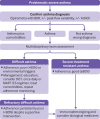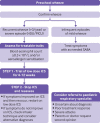Advances in the pathogenesis and personalised treatment of paediatric asthma
- PMID: 37841968
- PMCID: PMC10568124
- DOI: 10.1136/bmjmed-2022-000367
Advances in the pathogenesis and personalised treatment of paediatric asthma
Abstract
The diversity of pathology of severe paediatric asthma demonstrates that the one-size-fits-all approach characterising many guidelines is inappropriate. The term "asthma" is best used to describe a clinical syndrome of wheeze, chest tightness, breathlessness, and sometimes cough, making no assumptions about underlying pathology. Before personalising treatment, it is essential to make the diagnosis correctly and optimise basic management. Clinicians must determine exactly what type of asthma each child has. We are moving from describing symptom patterns in preschool wheeze to describing multiple underlying phenotypes with implications for targeting treatment. Many new treatment options are available for school age asthma, including biological medicines targeting type 2 inflammation, but a paucity of options are available for non-type 2 disease. The traditional reliever treatment, shortacting β2 agonists, is being replaced by combination inhalers containing inhaled corticosteroids and fast, longacting β2 agonists to treat the underlying inflammation in even mild asthma and reduce the risk of asthma attacks. However, much decision making is still based on adult data extrapolated to children. Better inclusion of children in future research studies is essential, if children are to benefit from these new advances in asthma treatment.
Keywords: asthma; pediatrics.
© Author(s) (or their employer(s)) 2023. Re-use permitted under CC BY-NC. No commercial re-use. See rights and permissions. Published by BMJ.
Conflict of interest statement
Competing interests: We have read and understood the BMJ policy on declaration of interests and declare the following interests: none.
Figures




Similar articles
-
Interventions for escalation of therapy for acute exacerbations of asthma in children: an overview of Cochrane Reviews.Cochrane Database Syst Rev. 2020 Aug 5;8(8):CD012977. doi: 10.1002/14651858.CD012977.pub2. Cochrane Database Syst Rev. 2020. PMID: 32767571 Free PMC article.
-
How to Choose the Correct Drug in Severe Pediatric Asthma.Front Pediatr. 2022 Jun 2;10:902168. doi: 10.3389/fped.2022.902168. eCollection 2022. Front Pediatr. 2022. PMID: 35722499 Free PMC article. Review.
-
Inhaled corticosteroids in children with persistent asthma: dose-response effects on growth.Evid Based Child Health. 2014 Dec;9(4):931-1046. doi: 10.1002/ebch.1989. Evid Based Child Health. 2014. PMID: 25504973
-
Clinical significance of cough and wheeze in the diagnosis of asthma.Arch Dis Child. 1996 Dec;75(6):489-93. doi: 10.1136/adc.75.6.489. Arch Dis Child. 1996. PMID: 9014600 Free PMC article.
-
Update in paediatric asthma management: where is evidence challenging current practice?J Paediatr Child Health. 2013 May;49(5):346-52. doi: 10.1111/j.1440-1754.2010.01975.x. Epub 2011 Apr 6. J Paediatr Child Health. 2013. PMID: 21470328 Review.
Cited by
-
Evaluating Severe Therapy-Resistant Asthma in Children: Diagnostic and Therapeutic Strategies.Medicina (Kaunas). 2024 Nov 2;60(11):1799. doi: 10.3390/medicina60111799. Medicina (Kaunas). 2024. PMID: 39596984 Free PMC article. Review.
-
Errors in Metered Dose Inhaler Use Amongst Pediatric Asthma Patients.J Asthma Allergy. 2023 Nov 20;16:1259-1265. doi: 10.2147/JAA.S435197. eCollection 2023. J Asthma Allergy. 2023. PMID: 38022753 Free PMC article.
References
-
- Royal College of Physicians . Why asthma still kills: the National Review of Asthma Deaths (NRAD) confidential enquiry Report.2014. Available: https://rcplondon.ac.uk/projects/outputs/why-asthma-still-kills [Accessed 16 Nov 2022].
-
- Asthma UK . Asthma facts and statistics.2018. Available: https://asthma.org.uk/about/media/facts-and-statistics [Accessed 2 Dec 2022].
-
- Drew R. Richard Asher talking sense. Proceedings of the Royal Society of Medicine 1973;66:488. 10.1177/003591577306600536 - DOI
Publication types
LinkOut - more resources
Full Text Sources
